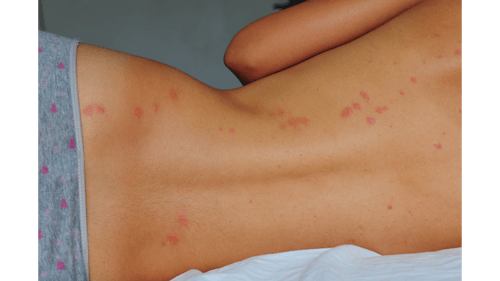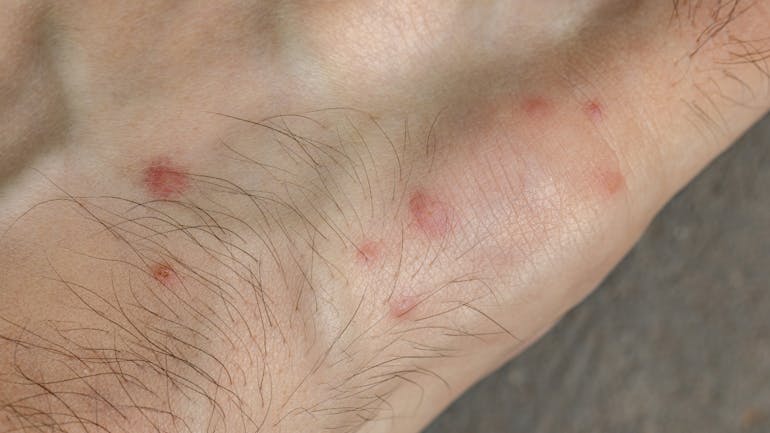Read our editorial policy to see how we create informative, accurate content.
Bed Bugs: Health Risks & How To Treat Bites
Reviewed and fact-checked by Alessandro Grenci, Superintendent Pharmacist. Read our editorial policy to see how we create informative, accurate content.
Where do you Find Bed bugs
Bed bugs are small, reddish-brown insects that feed on human blood. They are a common pest that can infest homes, hotels, and other buildings. The Times reports that incidences of bedbugs are increasing 65% over the last year.
Bed bugs can be introduced into a home or building by anyone, including guests and staff, as they catch a ride on clothing or luggage. Bed bugs are not a sign of poor sanitation, and they can be brought inside from other infested areas or from used furniture.
Bedbugs can hide in many places, including on bed frames, mattresses, clothing, furniture, behind pictures and under loose wallpaper.
Health Risks Associated with Bed Bugs
Bed bugs are not known to transmit diseases, but they can cause a variety of negative physical health, mental health, and economic consequences. Bed bugs are a public health pest, and their presence can cause anxiety, insomnia, and systemic reactions.
Effects of Bed Bug Bits
Bed bug bites affect each person differently. Bite responses can range from an absence of any physical signs of the bite to a serious allergic reaction. Bed bugs can cause a variety of negative health conditions. Some of these effects include:
- Allergic reactions to their bites, which can be severe. Effects range from no reaction to a small bite mark to, in rare cases, anaphylaxis (severe, whole-body reaction).
- Secondary infections of the skin from the bite reaction, such as impetigo, ecthyma, and lymphangitis.
- Mental health impacts on people living in infested homes. Reported effects include anxiety, insomnia, and systemic reactions.
Anxiety and Insomnia
Bed bugs can also cause psychological health risks such as anxiety and insomnia. Anxiety and insomnia can arise from the stress of dealing with a bed bug infestation and the fear of being bitten. Bed bugs are active at night when they leave their daytime resting place deep inside cracks and crevices to seek out human blood. This can cause anxiety and insomnia in people who are afraid of being bitten.
Signs of bedbugs include:
- Bites – often on skin exposed while sleeping, like the face, neck and arms
- Spots of blood on your bedding – from the bites or from squashing a bedbug
- Small brown spots on bedding or furniture (bedbug poo)
What do Bed Bug Bites Look Like
Bed bug bites can be difficult to distinguish from other insect bites, but they are typically itchy and may appear clustered or lined up in rough rows. Symptoms of bed bug bites are similar to symptoms of other insect bites and rashes. Bed bug bites are usually inflamed spots, often with a darker spot in the middle, itchy, arranged in a rough line or in a cluster

Where do bedbug bits occur?
Bed bugs can bite anywhere on the body where there is skin. While not always the case, bed bug bites are often grouped together in a small area and at times may occur in a line or a zigzag pattern. Typically, bites tend to occur on areas exposed during sleeping, such as:
- neck
- face
- hands
- shoulders
- arms
- and legs
Treatments for Bed Bug Bites
Bed bug bites usually clear up without treatment in a week or two. To relieve symptoms, you can try a few of the OTC medications below or some home remedies.
How to Treat Bed Bug Bites
At medino we have a variety of treatments to help soothe itching and inflammation following a bedbug bites. Here are the products recommended by our Superintendent Pharmacist Alessandro Grenci:
A mild steroid cream like hydrocortisone cream will soothe and ease bedbug bites, Careway Hydrocortisone 1% Cream 15g is an effective treatment for itching, irritation and inflammation.

Eurax have multiple creams that offer relief from skin itching and irritation. Eurax HC Cream 15g has a dual action, as well as relieving skin irritation it also targets insect bites specifically.

Anthisan Bite and Sting Cream 20g is specifically designed to provide relief from the irritation, pain and redness caused by insect bites.

An antihistamine such as Piriton Allergy Tablets may help if the bites are very itchy and you're unable to sleep.

After bite pens will help relieve the itch and burn of bites directly to the spot.

Things you can do at Home to Help
In addition to OTC medications, several home remedies may help relieve symptoms of bedbug bites.
- Putting something cool, like a clean, damp cloth, on the affected area to help with the itching and any swelling
- Keeping the affected area clean
- Not scratching the bites to avoid getting an infection
FAQ's
What Should I do if I Think I have a Bed Bug Infestation in my Home?
If you suspect that you have a bed bug infestation in your home, there are several steps you can take to get rid of them:
- Identify all infested areas.
- Contain the infestation.
- Prepare for bed bug treatment.
- Kill the bed bugs.
- Evaluate and prevent.
Here are some additional tips to help you get rid of bed bugs:
- Thoroughly vacuum your mattress, the insides of your dresser, the seams and joints of your furniture, your carpets, and any other place you’ve noticed signs of bed bug infestation.
- Seal the contents of your vacuum canister in a plastic bag and throw it away.
- Wash all bedding, linens, curtains, and clothing in hot water and dry them on the highest dryer setting.
- Use a stiff brush to scrub mattress seams to remove bed bugs and their eggs before vacuuming.
- Use a bed bug spray or powder to treat your mattress, box spring, and bed frame.
- Use a bed bug interceptor to trap bed bugs before they can climb up your bed frame.
- Hire a professional exterminator if you are unable to get rid of the bed bugs on your own.
What are the Best Ways to Prevent Bed Bug Infestations in My Home?
Here are some tips to help prevent bed bug infestations in your home:
- Check secondhand furniture, beds, and sofas for any signs of bed bug infestation before bringing them home.
- Decontaminate luggage, clothes, and belongings upon returning home (brushing, vacuuming, heating, washing, or freezing).
- When travelling use luggage racks to keep clothes off the floor and away from furniture.
- Run clothes through a drying cycle after you return from your travels and keep your suitcase away from your bed.
- Store clothes in vacuum-packed bags when travelling.
- Reduce clutter in your home to reduce hiding places for bed bugs.
- Vacuum frequently to remove any successful hitchhikers.
- Be vigilant when using shared laundry facilities. Transport items to be washed in plastic bags (if you have an active infestation, use a new bag for the journey home). Remove from the dryer directly into the bag and fold at home. (A dryer on high heat can kill bed bugs.)
- If you live in a multi-family home, try to isolate your unit by installing door sweeps on the bottom of doors to discourage movement into hallways and sealing cracks and crevices around baseboards, light sockets, etc., to discourage movement through wall voids.
Citations:
- The Times: London bedbugs: what to do if Paris infestation spreads to the UK
- NHS: Bedbugs
- Bed bug bites: What you need to know
- Mayo Clinic: Bedbugs
- Cleveland Clinic: Bed Bugs and Bed Bug Bites

